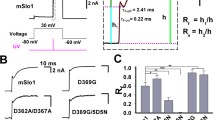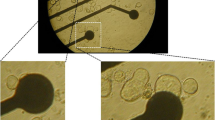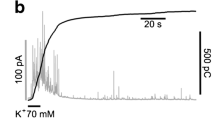Abstract
BK channels modulate cell firing in excitable cells in a voltage-dependent manner regulated by fluctuations in free cytosolic Ca2+ during action potentials. Indeed, Ca2+-independent BK channel activity has ordinarily been considered not relevant for the physiological behaviour of excitable cells. We employed the patch-clamp technique and selective BK channel blockers to record K+ currents from bovine chromaffin cells at minimal intracellular (about 10 nM) and extracellular (free Ca2+) Ca2+ concentrations. Despite their low open probability under these conditions (V50 of +146.8 mV), BK channels were responsible for more than 25% of the total K+ efflux during the first millisecond of a step depolarisation to +20 mV. Moreover, BK channels activated about 30% faster (τ = 0.55 ms) than the rest of available K+ channels. The other main source of fast voltage-dependent K+ efflux at such a low Ca2+ was a transient K+ (IA-type) current activating with V 50 = −14.2 mV. We also studied the activation of BK currents in response to action potential waveforms and their contribution to shaping action potentials both in the presence and the absence of extracellular Ca2+. Our results show that BK channels activate during action potentials and accelerate cell repolarisation even at minimal Ca2+ concentration, and suggest that they could do so also in the presence of extracellular Ca2+, before Ca2+ entering the cell facilitates their activity.







Similar content being viewed by others
Abbreviations
- AP:
-
Action potential
- APW:
-
Action potential waveform
- BKi :
-
Inactivating BK current or channel
- BKs :
-
Non-inactivating BK current or channel
- Ca 2+i :
-
Cytosolic Ca2+
- Ca 2+o :
-
Extracellular Ca2+
- ChTx:
-
Charybdotoxin
- HAD:
-
Half-amplitude duration
- IA :
-
Fast inactivating potassium current
- IbTx:
-
Iberiotoxin
- k i :
-
Rate constant of inactivation
- N-methyl-d-glucamine:
-
NMDG
- τ:
-
Time constant
- TEA:
-
Tetraethylammonium
- V h :
-
Holding potential
References
Artalejo AR (1995) Electrical properties of adrenal chromaffin cells. In: H. Scherübl and Hescheler J (ed) The electrophysiology of neuroendocrine cells. CRC Press Inc, pp. 259–299.
Artalejo AR, Garcia AG, Neher E (1993) Small-conductance Ca(2+)-activated K+ channels in bovine chromaffin cells. Pflügers Arch 423:97–103
Borst JG, Sakmann B (1998) Calcium current during a single action potential in a large presynaptic terminal of the rat brainstem. J Physiol 506:143–157
Butler A, Tsunoda S, McCobb DP, Wei A, Salkoff L (1993) mSlo, a complex mouse gene encoding “maxi” calcium-activated potassium channels. Science 261:221–224
Cannon SD, Wilson SP, Walsh KB (1994) A G protein-activated K+ current in bovine adrenal chromaffin cells: possible regulatory role in exocytosis. Mol Pharmacol 45:109–116
Chang CP, Dworetzky SI, Wang J, Goldstein ME (1997) Differential expression of the alpha and beta subunits of the large-conductance calcium-activated potassium channel: implication for channel diversity. Brain Res Mol Brain Res 45:33–40
Coetzee WA, Amarillo Y, Chiu J, Chow A, Lau D, McCormack T, Moreno H, Nadal MS, Ozaita A, Pountney D, Saganich M, de Vega-Saenz ME, Rudy B (1999) Molecular diversity of K+ channels. Ann N Y Acad Sci 868:233–285
Connor JA (1980) The fast K+ channel and repetitive firing. In: Neurosciences CSHRit (ed) Molluscan nerve cells: From biophysics to behaviour, pp. 126–133. Cold Spring Harbor Laboratory Press, Woodbury NY
Ding JP, Lingle CJ (2002) Steady-state and closed-state inactivation properties of inactivating BK channels. Biophys J 82:2448–2465
Ding JP, Li ZW, Lingle CJ (1998) Inactivating BK channels in rat chromaffin cells may arise from heteromultimeric assembly of distinct inactivation-competent and noninactivating subunits. Biophys J 74:268–289
Dopico AM, Widmer H, Wang G, Lemos JR, Treistman SN (1999) Rat supraoptic magnocellular neurones show distinct large conductance, Ca2+-activated K+ channel subtypes in cell bodies versus nerve endings. J Physiol 519:101–114
Garcia AG, Garcia-De-Diego AM, Gandia L, Borges R, Garcia-Sancho J (2006) Calcium signaling and exocytosis in adrenal chromaffin cells. Physiol Rev 86:1093–1131
Garcia-Guzman M, Calvo S, Cena V, Criado M (1992) Molecular cloning and permanent expression in a neuroblastoma cell line of a fast inactivating potassium channel from bovine adrenal medulla. FEBS Lett 308:283–289
Ghatta S, Nimmagadda D, Xu X, O’Rourke ST (2006) Large-conductance, calcium-activated potassium channels: structural and functional implications. Pharmacol Ther 110:103–116
Gonzalez-Garcia C, Ceña V, Keiser HR, Rojas E (1993) Catecholamine secretion induced by tetraethylammonium from cultured bovine adrenal chromaffin cells. Biochim Biophys Acta 1177:99–105
Hanner M, Schmalhofer WA, Munujos P, Knaus HG, Kaczorowski GJ, Garcia ML (1997) The beta subunit of the high-conductance calcium-activated potassium channel contributes to the high-affinity receptor for charybdotoxin. Proc Natl Acad Sci USA 94:2853–2858
Heinemann C, von Rüden L, Chow RH, Neher E (1993) A two-step model of secretion control in neuroendocrine cells. Pflügers Arch 424:105–112
Horn R (1991) Estimating the number of channels in patch recordings. Biophys J 60:433–439
Horrigan FT, Aldrich RW (2002) Coupling between voltage sensor activation, Ca2+ binding and channel opening in large conductance (BK) potassium channels. J Gen Physiol 120:267–305
Horrigan FT, Cui J, Aldrich RW (1999) Allosteric voltage gating of potassium channels I. Mslo ionic currents in the absence of Ca(2+). J Gen Physiol 114:277–304
Kaczorowski GJ, Garcia ML (1999) Pharmacology of voltage-gated and calcium-activated potassium channels. Curr Opin Chem Biol 3:448–458
Latorre R, Morera FJ, Zaelzer C (2010) Allosteric interactions and the modular nature of the voltage- and Ca2+-activated (BK) channel. J Physiol 588:3141–3148
Llinas R, Sugimori M, Simon SM (1982) Transmission by presynaptic spike-like depolarization in the squid giant synapse. Proc Natl Acad Sci USA 79:2415–2419
Lovell PV, McCobb DP (2001) Pituitary control of BK potassium channel function and intrinsic firing properties of adrenal chromaffin cells. J Neurosci 21:3429–3442
Lovell PV, James DG, McCobb DP (2000) Bovine versus rat adrenal chromaffin cells: big differences in BK potassium channel properties. J Neurophysiol 83:3277–3286
Malin SA, Nerbonne JM (2001) Molecular heterogeneity of the voltage-gated fast transient outward K+ current, I(Af), in mammalian neurons. J Neurosci 21:8004–14
Marcantoni A, Vandael DH, Mahapatra S, Carabelli V, Sinnegger-Brauns MJ, Striessnig J, Carbone E (2010) Loss of Cav1.3 channels reveals the critical role of L-type and BK channel coupling in pacemaking mouse adrenal chromaffin cells. J Neurosci 30:491–504
Marty A (1981) Ca-dependent K channels with large unitary conductance in chromaffin cell membranes. Nature 291:497–500
Marty A, Neher E (1985) Potassium channels in cultured bovine adrenal chromaffin cells. J Physiol 367:117–141
McManus OB, Helms LM, Pallanck L, Ganetzky B, Swanson R, Leonard RJ (1995) Functional role of the beta subunit of high conductance calcium-activated potassium channels. Neuron 14:645–50
Meera P, Wallner M, Toro L (2000) A neuronal beta subunit (KCNMB4) makes the large conductance, voltage- and Ca2+ -activated K+ channel resistant to charybdotoxin and iberiotoxin. Proc Natl Acad Sci USA 97:5562–5567
Moro MA, Lopez MG, Gandia L, Michelena P, Garcia AG (1990) Separation and culture of living adrenaline- and noradrenaline-containing cells from bovine adrenal medullae. Anal Biochem 185:243–248
Muller A, Kukley M, Uebachs M, Beck H, Dietrich D (2007) Nanodomains of single Ca2+ channels contribute to action potential repolarisation in cortical neurons. J Neurosci 27:483–95
Naraghi M, Neher E (1997) Linearized buffered Ca2+ diffusion in microdomains and its implications for calculation of [Ca2+] at the mouth of a calcium channel. J Neurosci 17:6961–6973
Pancrazio JJ, Johnson PA, Lynch C 3rd (1994) A major role for calcium-dependent potassium current in action potential repolarisation in adrenal chromaffin cells. Brain Res 668:246–251
Prakriya M, Lingle CJ (2000) Activation of BK channels in rat chromaffin cells requires summation of Ca(2+) influx from multiple Ca(2+) channels. J Neurophysiol 84:1123–1135
Robitaille R, Garcia ML, Kaczorowski GJ, Charlton MP (1993) Functional colocalization of calcium and calcium-gated potassium channels in control of transmitter release. Neuron 11:645–55
Rudy B (1988) Diversity and ubiquity of K channels. Neuroscience 25:729–49
Sala S, Soria B (1991) Inactivation of Delayed Potassium Current in Cultured Bovine Chromaffin Cells. Eur J Neurosci 3:462–472
Sanchez M, McManus OB (1996) Paxilline inhibition of the alpha-subunit of the high-conductance calcium-activated potassium channel. Neuropharmacology 35:963–968
Solaro CR, Lingle CJ (1992) Trypsin-sensitive, rapid inactivation of a calcium-activated potassium channel. Science 257:1694–1698
Solaro CR, Prakriya M, Ding JP, Lingle CJ (1995) Inactivating and noninactivating Ca(2+)- and voltage-dependent K+ current in rat adrenal chromaffin cells. J Neurosci 15:6110–6123
Sun XP, Schlichter LC, Stanley EF (1999) Single-channel properties of BK-type calcium-activated potassium channels at a cholinergic presynaptic nerve terminal. J Physiol 518:639–651
Sun L, Xiong Y, Zeng X, Wu Y, Pan N, Lingle CJ, Qu A, Ding J (2009) Differential regulation of action potentials by inactivating and noninactivating BK channels in rat adrenal chromaffin cells. Biophys J 97:1832–1842
Tanaka Y, Meera P, Song M, Knaus HG, Toro L (1997) Molecular constituents of maxi KCa channels in human coronary smooth muscle: predominant alpha + beta subunit complexes. J Physiol 502:545–557
Torres YP, Morera FJ, Carvacho I, Latorre R (2007) A marriage of convenience: beta-subunits and voltage-dependent K+ channels. J Biol Chem 282:24485–24489
Twitchell WA, Rane SG (1993) Opioid peptide modulation of Ca(2+)-dependent K+ and voltage-activated Ca2+ currents in bovine adrenal chromaffin cells. Neuron 10:701–709
Uebele VN, Lagrutta A, Wade T, Figueroa DJ, Liu Y, McKenna E, Austin CP, Bennett PB, Swanson R (2000) Cloning and functional expression of two families of beta-subunits of the large conductance calcium-activated K+ channel. J Biol Chem 275:23211–23218
Ulate G, Scott SR, Gonzalez J, Gilabert JA, Artalejo AR (2000) Extracellular ATP regulates exocytosis in inhibiting multiple Ca(2+) channel types in bovine chromaffin cells. Pflügers Arch 439:304–314
Valverde MA, Rojas P, Amigo J, Cosmelli D, Orio P, Bahamonde MI, Mann GE, Vergara C, Latorre R (1999) Acute activation of Maxi-K channels (hSlo) by estradiol binding to the beta subunit. Science 285:1929–1931
Vandael DH, Marcantoni A, Mahapatra S, Caro A, Ruth P, Zuccotti A, Knipper M, Carbone E (2010) Ca(v)1.3 and BK channels for timing and regulating cell firing. Mol Neurobiol 42:185–198
Wallace DJ, Chen C, Marley PD (2002) Histamine promotes excitability in bovine adrenal chromaffin cells by inhibiting an M-current. J Physiol 540:921–939
Wallner M, Meera P, Toro L (1999) Molecular basis of fast inactivation in voltage and Ca2+-activated K+ channels: a transmembrane beta-subunit homolog. Proc Natl Acad Sci USA 96:4137–4142
Xia XM, Ding JP, Lingle CJ (1999) Molecular basis for the inactivation of Ca2+- and voltage-dependent BK channels in adrenal chromaffin cells and rat insulinoma tumor cells. J Neurosci 19:5255–5264
Xia XM, Ding JP, Zeng XH, Duan KL, Lingle CJ (2000) Rectification and rapid activation at low Ca2+ of Ca2+-activated, voltage-dependent BK currents: consequences of rapid inactivation by a novel beta subunit. J Neurosci 20:4890–4903
Zeng XH, Ding JP, Xia XM, Lingle CJ (2001) Gating properties conferred on BK channels by the beta3b auxiliary subunit in the absence of its NH(2)- and COOH termini. J Gen Physiol 117:607–628
Acknowledgments
We thank Dr. Antonio G. García for the generous supply of chromaffin cell cultures, and Drs. Paola Imbrici and Arnaud Ruiz for their valuable comments on the manuscript. Useful discussions with Drs. Juan Antonio Gilabert and Guido Ulate are also greatly acknowledged. This work was supported by grants from the Spanish Ministerio de Ciencia e Innovación (BFU2005-06034; Spanish Ion Channel Initiative (SICI) grant CSD2008-00005) to A.R.A. and (RYC-2009-03979 and SAF2010-20604) to R.S.S.
Author information
Authors and Affiliations
Corresponding author
Electronic supplementary material
Below is the link to the electronic supplementary material.
Supplemental Figure 1
Effect of paxilline on K+ currents from bovine chromaffin cells at minimal Ca 2+i . A Effect of paxilline (1 μM, 10 min) on K+ currents activated by 600 ms-long depolarisations from a V h of −70 mV (left panels) or 0 mV (right panels). Upper panels show the corresponding voltage protocols. B Effect of paxilline on peak current amplitudes at the different test potentials from cells with the membrane voltage held at −70 mV (left panel) or 0 mV (right panel). Data are mean±SEM of five to eight experiments. *p < 0.001 (PDF 189 kb)
Supplemental Figure 2
Effect of TEA on K+ currents from chromaffin cells at minimal Ca 2+i . A Effect of TEA (30 mM) on K+ currents activated by 600 ms-long depolarisations from a V h of −70to 0 mV up to +120, in 20 mV steps (see the adjoining protocol). B Effect of different concentrations of TEA (3, 10 and 30 mM) on peak currents evoked by the voltage protocol employed in A. C, left panel. Effect of TEA (30 mM) on the rate of inactivation (v i) of K+ currents elicited V h of −70 mV to the indicated potentials; right panel. Effect of TEA (30 mM) on the rate of inactivation (k i) of K+ currents elicited by 600 ms-long depolarisations from a V h of 0 mV to the indicated potentials. Data are means±SEM of eight experiments. *p < 0.05, **p < 0.01 with respect to control values (PDF 23 kb)
Supplemental Figure 3
K+-tail currents from bovine chromaffin cells at minimal Ca 2+i . A, left panel. Tail currents (arrow) observed upon repolarisation to −70 mV from different test potentials in a chromaffin cell held at a V h of 0 mV (see the adjoining protocol); tail current amplitudes were subsequently used to build the activation curve for BK channels (right panel). The Boltzmann function fitted to the experimental data gave a value of +146.8 mV for V 50, and of 31.71 mV for K. Data were normalised with respect to the maximal current derived from curve fitting. B, left panel. Effect of IbTx (150 nM, 5 min) on K+ currents elicited by graded depolarisations from a V h of −70 mV (see the adjoining protocol); right panel. Tail current amplitudes before (Control) and after treatment with IbTx (IbTx) were used to build the corresponding activation curves. A Boltzmann function fitted to tail currents in the presence of IbTx gave values for V 50 and K of −14.2 and 11.94 mV, respectively. Values were normalised with respect to the maximal current derived from curve fitting to data in the presence of IbTx. Data are means ± SEM of eight and seven cells for panel A and B, respectively (PDF 202 kb)
Supplemental Figure 4
Time course of recovery from inactivation of I A and BK current at minimal Ca 2+i . A, upper panel. BK currents activated by a series of variably spaced pairs of of 600 ms-long voltage depolarisations to +100 mV from a V h of 0 mV (see voltage protocol); lower panel. Peak currents (I 1 and I 2) in response to paired pulses were ratioed (I 2/I 1) and plotted against the interpulse interval. Experimental data were fitted by a double exponential function with two rate constants: k fast = 23 s−1 and k slow = 0.77 s−1; an expanded view of the faster recovery component is shown as an inset. B, upper panel. I A currents were elicited by variably spaced pairs of 600 ms-long voltage depolarisations to +20 mV from a V h of −70 mV; lower panel. Peak current responses (I 1 and I 2) to paired pulses were ratioed (I 2/I 1) and plotted against the interpulse interval. The result of fitting a double exponential function with rate constants k fast = 27 s−1 and a k slow = 1.84 s−1, is shown; an expanded view of the faster recovery component is also shown as an inset. Data are means ± SEM of seven cells for each type of current (PDF 29 kb)
Supplemental Figure 5
Effect of paxilline on K+ currents induced by action potential waveforms in the presence of 2 mM Ca 2+o . A Perforated-patch recordings of K+ currents (black traces) induced by a fast (left panel) or a slow (right panel) action potential waveform (APW; dashed lines) from a chromaffin cell bathed in a solution containing 2 mM Ca2+. Blue traces depict the current remaining after the administration of paxilline (1 μM, 10 min). Red traces result from subtracting the blue traces (in the presence of paxilline) from the black ones (Control), hence corresponding to the BK current. Dotted lines denote the 0 mV level. Notice the existence of two peaks of BK current: the first peak coincides with the peak of the APW whereas the second delayed one occurs in the late repolarising phase of the APW. B Example of Ca2+ currents induced by a fast ramp-based APW from a chromaffin cell bathed in a solution containing 2 mM Ca2+ and 140 mM NMDG. The cell was dialysed with a solution containing 140 mM CsCl (PDF 56 kb)
Rights and permissions
About this article
Cite this article
Scott, R.S., Bustillo, D., Olivos-Oré, L.A. et al. Contribution of BK channels to action potential repolarisation at minimal cytosolic Ca2+ concentration in chromaffin cells. Pflugers Arch - Eur J Physiol 462, 545–557 (2011). https://doi.org/10.1007/s00424-011-0991-9
Received:
Accepted:
Published:
Issue Date:
DOI: https://doi.org/10.1007/s00424-011-0991-9




